英语句子种类与类型
- 格式:ppt
- 大小:378.00 KB
- 文档页数:29
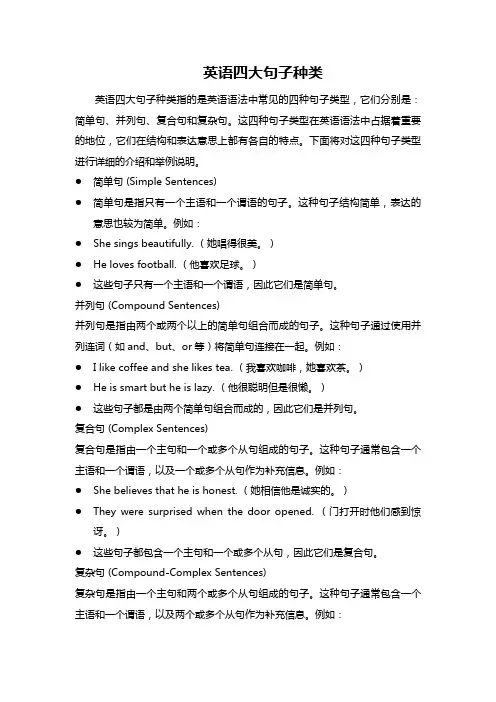
英语四大句子种类英语四大句子种类指的是英语语法中常见的四种句子类型,它们分别是:简单句、并列句、复合句和复杂句。
这四种句子类型在英语语法中占据着重要的地位,它们在结构和表达意思上都有各自的特点。
下面将对这四种句子类型进行详细的介绍和举例说明。
●简单句 (Simple Sentences)●简单句是指只有一个主语和一个谓语的句子。
这种句子结构简单,表达的意思也较为简单。
例如:●She sings beautifully. (她唱得很美。
)●He loves football. (他喜欢足球。
)●这些句子只有一个主语和一个谓语,因此它们是简单句。
并列句 (Compound Sentences)并列句是指由两个或两个以上的简单句组合而成的句子。
这种句子通过使用并列连词(如and、but、or等)将简单句连接在一起。
例如:●I like coffee and she likes tea. (我喜欢咖啡,她喜欢茶。
)●He is smart but he is lazy. (他很聪明但是很懒。
)●这些句子都是由两个简单句组合而成的,因此它们是并列句。
复合句 (Complex Sentences)复合句是指由一个主句和一个或多个从句组成的句子。
这种句子通常包含一个主语和一个谓语,以及一个或多个从句作为补充信息。
例如:●She believes that he is honest. (她相信他是诚实的。
)●They were surprised when the door opened. (门打开时他们感到惊讶。
)●这些句子都包含一个主句和一个或多个从句,因此它们是复合句。
复杂句 (Compound-Complex Sentences)复杂句是指由一个主句和两个或多个从句组成的句子。
这种句子通常包含一个主语和一个谓语,以及两个或多个从句作为补充信息。
例如:●We know that she is a good student, although she is often late forschool. (我们知道她是一个好学生,尽管她经常上学迟到。
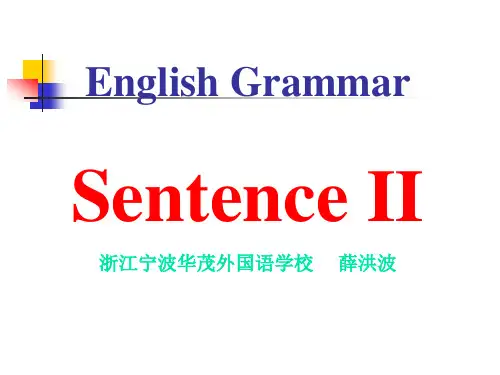
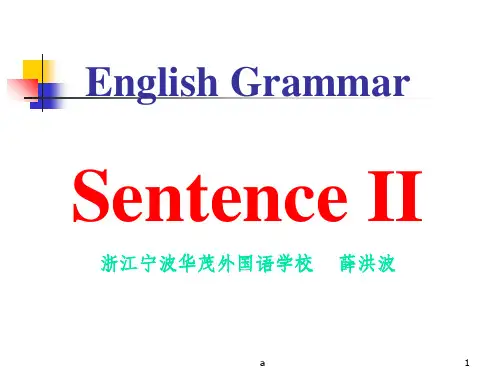

句子的种类英语中句子可以分为四种类型,即陈述句,疑问句,祈使句和感叹句.一陈述句陈述句是用来陈述一项事实的句子,它有明确的主语和谓语部分.如果不是在特殊条件下有意倒装,正常语序应是”主语+谓语动词”的顺序.它包括肯定句和否定句.He is a student.We went to Canada yesterday.They haven’t finished their homework.You should get up earlier next time.二,疑问句疑问句是用来提出疑问的句子,句末用问号.它又可分为一般疑问句,特殊疑问句,选择疑问句和反意疑问句/附加疑问句.1.一般疑问一般疑问句是用yes 或no 回答的问句,常意为”……吗?”朗读时句末用升调.(1)含有情态动词的一般疑问句,通常是把情态动词提前来表示疑问语气,答语中仍用该情态动词.Will they go to the town tomorrow?Yes, they will,/ No,they won’tCan you speak English ?Yes,I can / No, I can’t注意: 对may, must 的否定回答,根据含义不能保证在情态动词上对应一致,May I smoke here ?No, you mustn’t .It’s dangerous.May I borrow your bike ?Sorry/No,you can’t ,My wife is using it now .Must I finish the work now ?No,you needn’t You can finish it tomorrow.当情态动词开头的问句表示”征求意见”或”提供帮助”时,答语要灵活运用.Can I help you ?Yes, pleaseShall we go now ?Ok/All right / Good idea.(2)系动词BE 独立作谓语的句子通常是把be提前以表示疑问语气.Are you a doctor ?Is your mother American ?(3)句中含有助动词的,把助动词提前倒装以表示疑问语气.Have you a new dictionary ?Yes,I haveHave you met him before ?Yes, I have/ No, I haven’t(4)实义动词原形独立作谓语时,要借助do的适当形式提前来表示疑问.Do you understand me ?Yes, I do /No, I don’tDoes she like music ? Yes, she does/ No, she doesn’tDid you do your lessons last night ? Yes,I did / No, I didn’t2.特殊疑问句特殊疑问句是由”疑问词+一般疑问句”构成的,根据疑问部分在句子中所作的成分而确定使用哪个疑问词.(1)特殊疑问句是由疑问代词what, who, whom ,which,whose., 或疑问副词when, where , why , how 引导的疑问句.What are you going to do tomorrow?Who will teach you English next term ?Which book is yours ?Whose son was ill yesterday?(2)对于不同句子成分和不同情况提问,要求用不同的特殊疑问词.A WHO 对主语进行提问Who is that boy?B, whom/who 对宾语进行提问Whom are you waiting for ?C,whose 对定语进行提问Whose bike is broken ?D,how many 对可数名词的数量提问How many books do you have ?E, how much 对不可数名词的数量提问How much water is there in the bottle ?F when 对具体时间进行提问, when will you go ?G what time 对”钟点”进行提问What time did you get up this morning?H, how often 对表示频率的词进行提问: How often do you write to your father ?I, How soon 对表示”多久以后”进行提问: How soon will they come back?J How long 对表示一段时间的时间状语提问: How long have you worked here ?K where 对表示地点的状语提问: where have you been ?L how 对表示”如何”进行提问. How was your mother then ?M, why 对原因进行提问. Why were you late for the meeting?N, what 对表示”什么”进行提问: What will your mother say to you ?3.选择疑问句选择疑问句是用选择连词or 将提出询问的可选择的部分连接起来.可选择部分可以指人,事物,动作,状态,地点或行为方式等.若可选择部分超过两项,前边名项之间常用逗号隔开,只把最后两项用or连接.在朗读选择疑问句时,or前的可选择部分用升调,后一部分用降调.(1)一般形式的选择疑问句.Are you from the USA or Canada?Does he speak English or French ?Do you go to school by bus or on foot ?Is that boy Tom or Jim ?Shall we do it tocay,tomorrow or the day after tomorrow?(2)特殊形式的选择疑问句Which is bigger,the moon or the earth?Where are you going,London,Paris,Tokyo or New York?3.反意疑问句(又称附加疑问句)这种问句通常由两部分组成,前一部分一般为一个陈述句,后一部分附加一个简单的一般疑问句,中间用逗号隔开,所以又称为附加疑问句.这种问句要注意以下几点.(1)前后一般不能同时为肯定或否定形式.(2)附加疑问部分的主语是与前边陈述部分的主语保持一致的代词.(3)附加疑问部分若是否定形式,谓语动词应是与NOT的缩写式.(4)前后两部分谓语动词应在人称,数以及时态等方面保持语法上的一致.(5)仍用Yes 或no 的形式来回答.You are a student , aren’t you ?She can’t speak English , can she ?Jim likes playing football , doesn’t he ?Han Mei and Wei Hua haven’t finished their homework yet, have they ?注意: 在某些较少的场合下,反意疑问句也有不符合上述规则的情况存在,常见的几种特殊形式:A, 当前边陈述部分为祈使句时,分两种情况:(1)若是以Let’s 开头的祈使句,附加疑问部分用shall we ,而以Let u代替.Let me 等开头时,则用will you .Let’s dance to the music , shall we ?Let us go out and play games,will you ?(2)以其它实义动词开头的祈使句,附加疑问部分用will you 来完成.Go and get some milk ,will you ?Be sure to be safe ,will you ?B: 当陈述部分是”There be”结构时,附加疑问部分的主语也用ThereThere is only one desk here ,isn’t there ?aren’t any wild animals in the mountains ,are there ?C:当陈述部分带有never,nobody,nothing, none ,nowhere , seldom,hardly rarely,few,little等否定词或半否定词时,附加疑问部分的动词用肯定形式.Bob never got drunk ,did he ?Few people have been there before ,did they ?She does little work at home ,does she ?Nobody else knows about that except him , do they ?D: :当陈述部分主语是由every ,no ,some 构成的不定代词时,如果表示人,附加疑问部分的主语用they,若表示事物,则用it .Someone used my bike, didn’t they ?Nobody can solve the problem,can they ?Everything is Ok,isn’t it ?Nothing can be done now , is it ?E: :当陈述部分”I’m …”结构时,附加疑问部分用aren’t I.I’m late , aren’t I?F当陈述部分带有”that”的从句作主从复合句的宾语时,附加疑问部分应与主句的主谓形式保持一致.She knows (that) I lost it ,doesn’t she ?G :当陈述部分主句是:I think / believe /suppose/guess/expect/imagine/hope/feel 等结构时,附加疑问部分要与that 从句中的主谓形式保持一致,但注意否定转移.I think (that) he’s careless , isn’t he ?I don’t believe (that)she will leave,will she ?H 当陈述部分带有表示”有”的含义的动词have 时,附加疑问部分既可以用have,又可以用do当have不表示”有”的含义时,附加疑问部分应用do.You have a new watch, haven’t/don’t you ?She hasn’t many friends,has she?They don’t have enough time to do it , do they ?He has dinner at six in the evening, doesn’t he ? (不用hasn’t)I 当陈述部分有情态动词used to 时,附加疑问部分既可以用used to的形式,也可以用didShe used to be out-going,usedn’t/didn’t she ?J当陈述部分有情态动词needn’t,附加疑问部分用need,也可以用mustYou needn’t do that,,need you /must you ?K当陈述部分有情态动词”must”如果must表示”必须”附加疑问部分用mustn’t , “must “表示”必要”附加疑问句部分用”needn’t”. “must”表示”一定,想必”等推测意义,附加疑问部分则要根据陈述部分的结构,采用相应的系动词式助动词形式.You muxt work harder next term , mustn’t you j/You must go right now,needn’t you ?He must be very happy,isn’t he ?She must have come back, hasn’t she ?三,祈使句祈使句是以实义动词原形开头的表示”命令,要求,建议”或”征求意见”等语气的句型.否定式为Don’t+动词原形”读时常用降调,有时动词前加do可以加强句子的语气.表示客气时可加please置于句首或句尾,在句尾时前有逗号隔开.Look at the blackboard, please.Be quick,/ Hurry, up.Don’t do that againDo remember to call back.Let’s have a talk.注意有些名词复数的使用可以起到祈使句的作用.Thanks very much /a lot.(Many thanks)CongratulationsBest wishes to you .四,感叹句感叹句是由感叹词加上一个陈述句来构成的,用以抒发感情.句尾用感叹号,读降调.感叹句实际上就是对句中程度副词语气上的加强.常见的感叹词为how , what .用how 时,感叹部分的中心词是形容词或副词;用what 时,感叹部分的中心词为名词.1.what(a/an) +形容词+名词+主语+谓语!What an interesting story it is ?What beautiful paintings they are ?What good news it is ?2..How +形容词/副词+主语+谓语!How bright the room is !How beautifully she draws!How fast Tom runs!3.. How +形容词+a/an++名词+主语+谓语!How tall a man he is !How good a film we have seen !4.How+主语+谓语!How I miss my mother!How Tom’s mother regrets it !5.否定式感叹句有些句子在形式上是否定疑问句但在功能上是感叹句,这种句子的句尾既可以用问号又呆以用感叹号.Isn’t it a beautiful day !Haven’t things developed!注意: 使用what时,如果感叹部分的中心名词为单数可数名词,要有a/an在what后,否则不要加冠词.在条件具备的情况下,how , what的感叹句可以进行转换.What a kind girl she is !=How kind the girl is !在上文有所交代或含义比较明显时,可以只保留感叹部分而把主谓部分省略掉.Eg: What beautiful flowers (they are )!How cold (it is )!。
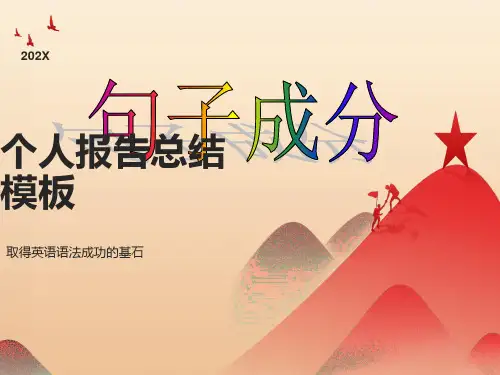
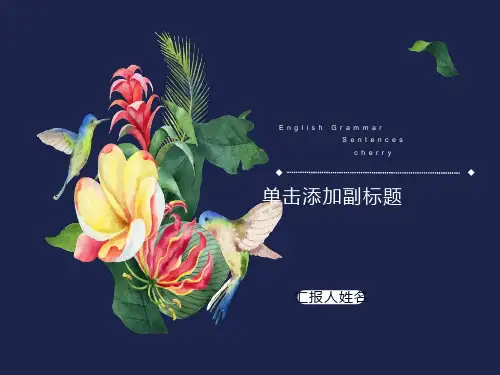
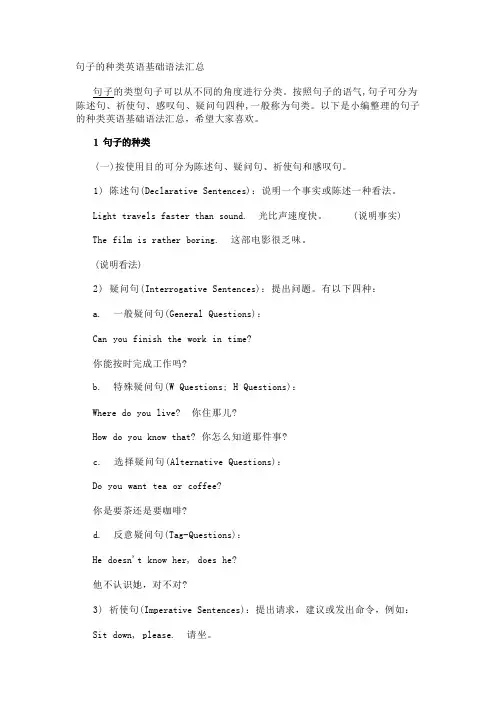
句子的种类英语基础语法汇总句子的类型句子可以从不同的角度进行分类。
按照句子的语气,句子可分为陈述句、祈使句、感叹句、疑问句四种,一般称为句类。
以下是小编整理的句子的种类英语基础语法汇总,希望大家喜欢。
(一)按使用目的可分为陈述句、疑问句、祈使句和感叹句。
1) 陈述句(Declarative Sentences):说明一个事实或陈述一种看法。
Light travels faster than sound. 光比声速度快。
(说明事实)The film is rather boring. 这部电影很乏味。
(说明看法)2) 疑问句(Interrogative Sentences):提出问题。
有以下四种:a. 一般疑问句(General Questions):Can you finish the work in time?你能按时完成工作吗?b. 特殊疑问句(W Questions; H Questions):Where do you live? 你住那儿?How do you know that? 你怎么知道那件事?c. 选择疑问句(Alternative Questions):Do you want tea or coffee?你是要茶还是要咖啡?d. 反意疑问句(Tag-Questions):He doesn't know her, does he?他不认识她,对不对?3) 祈使句(Imperative Sentences):提出请求,建议或发出命令,例如:Sit down, please. 请坐。
Don't be nervous! 别紧张!4) 感叹句(Exclamatory Sentences):表示说话人惊奇、喜悦、愤怒等情绪,例如:What good news it is! 多好的消息啊!(二)句子按其结构可以分为以下三类:1) 简单句(Simple Sentences):只包含一个主谓结构句子叫简单句,例如:She is fond of collecting stamps. 她喜欢集邮。
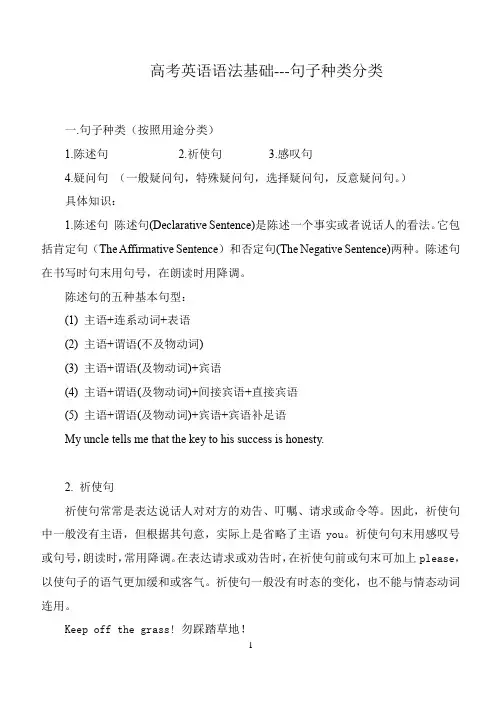
高考英语语法基础---句子种类分类一.句子种类(按照用途分类)1.陈述句2.祈使句3.感叹句4.疑问句(一般疑问句,特殊疑问句,选择疑问句,反意疑问句。
)具体知识:1.陈述句陈述句(Declarative Sentence)是陈述一个事实或者说话人的看法。
它包括肯定句(The Affirmative Sentence)和否定句(The Negative Sentence)两种。
陈述句在书写时句末用句号,在朗读时用降调。
陈述句的五种基本句型:(1) 主语+连系动词+表语(2) 主语+谓语(不及物动词)(3) 主语+谓语(及物动词)+宾语(4) 主语+谓语(及物动词)+间接宾语+直接宾语(5) 主语+谓语(及物动词)+宾语+宾语补足语My uncle tells me that the key to his success is honesty.2. 祈使句祈使句常常是表达说话人对对方的劝告、叮嘱、请求或命令等。
因此,祈使句中一般没有主语,但根据其句意,实际上是省略了主语you。
祈使句句末用感叹号或句号,朗读时,常用降调。
在表达请求或劝告时,在祈使句前或句末可加上please,以使句子的语气更加缓和或客气。
祈使句一般没有时态的变化,也不能与情态动词连用。
Keep off the grass! 勿踩踏草地!Always keep in mind that your main task is to get this company running smoothly.3. 感叹句感叹句的基本构成形式1).What(+a/an)+形容词+名词+主语+谓语!2).How+形容词+a/an+可数名词单数+主语+谓语!3).How+形容词/副词+主语+谓语!You can't imagine how crucial a role the pigeons played in the battlefields.你无法想象在过去的战场山鸽子发挥了多么重要的作用。
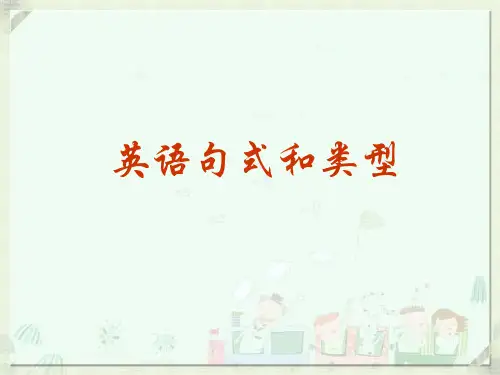
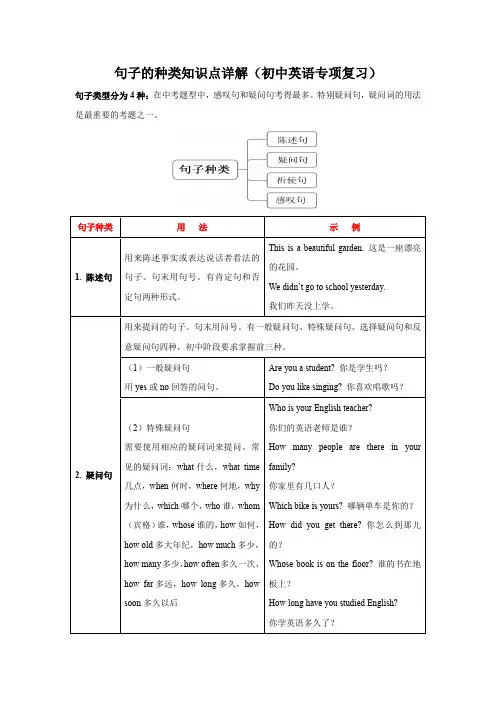
句子的种类知识点详解(初中英语专项复习)句子类型分为4种:在中考题型中,感叹句和疑问句考得最多。
特别疑问句,疑问词的用法是最重要的考题之一。
【典例】1. 他们还赢得了广东省飞镖比赛冠军。
多么棒的项目啊!They won the Championship of Guangdong Darts Match, too. ________________________ project it is!【答案】What a wonderful【解析】根据题干可知此处是一个感叹句。
中心词为可数名词project“项目”,符合结构:What+ a/an+形容词+主语+谓语。
project是以辅音音素开头,应用a;wonderful“极好的”。
故填What a wonderful。
2.. ________ it was to see the main sights of the world in the World Park!A How amazing day B. How an amazing dayC. What amazing dayD. What an amazing day【答案】D【解析】句意:在世界公园里看到世界的主要景点是多么美妙的一天啊!考查感叹句。
句子是感叹句,中心词是可数名词单数day,用感叹句结构:What a/an adj. n.+主谓。
故选D。
3.. —China won all the gold medals at the 2023 World Table Tennis Championships.—______ exciting news!A. What aB. How aC. HowD. What 【答案】D【解析】句意:——中国包揽了2023年世乒赛的所有金牌。
——多么令人兴奋的消息啊!考查感叹句,感叹句的中心词news是不可数名词,此处用“What+形容词+不可数名词”结构。
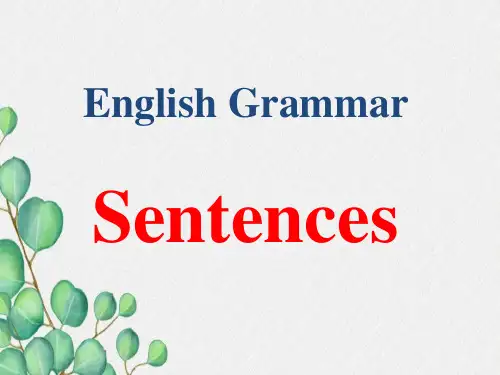
英语语法句子的种类一、陈述句陈述句是最常见的句子类型,用于陈述事实、描述情况或表达观点。
例句:- I go to school every day.- She is a doctor.- They live in New York.二、疑问句疑问句用于询问信息、寻求答案或确认事实。
例句:- Do you like pizza?- Where is the nearest post office?- Did you see the movie?三、祈使句祈使句用于表达请求、命令、建议或劝告。
例句:- Please close the door.- Don't forget to bring your umbrella.- Let's go for a walk.四、感叹句感叹句用于表达惊讶、赞美、失望或其他强烈的情感。
例句:- What a beautiful sunset!- How delicious the food is!- I can't believe we won the game!五、条件句条件句用于表达条件和结果之间的关系。
例句:- If it rains, we will stay indoors.- Unless you study hard, you will fail the exam.六、比较句比较句用于表示两个或多个事物之间的比较。
例句:- John is taller than Peter.- She sings better than him.- I prefer coffee to tea.七、否定句否定句用于否定陈述句中的内容。
例句:- I didn't see him at the party.- She doesn't like spicy food.- They haven't visited that museum before.。
英语语法句子种类与类型
英语语法中的句子种类主要有以下几种:
1. 陈述句(declarative sentence):用于陈述一个事实、观点、
情况等,以陈述句调子末尾的句点表示。
例:She is studying English.
2. 疑问句(interrogative sentence):用于提出问题,以问号结尾。
例:Is she studying English?
3. 命令句(imperative sentence):用于表达命令或请求,常以动
词原形开头。
例:Please study for your test.
4. 感叹句(exclamatory sentence):用于表达强烈的感情或感叹,以感叹号结尾。
例:What a beautiful sunset!
此外,还有一些特殊类型的句子,如:
1. 条件句(conditional sentence):用于表达假设、条件等情况,包括主从句结构。
例:If it rains, we will stay at home.
例:I like to read books, and my brother likes to watch movies.
3. 从句(subordinate clause):作为主句的一部分,常用连接词引导,包括定语从句、名词性从句和状语从句等。
例:The book that I bought yesterday is very interesting.。
一.句子按其结构可以分为以下三类:1)简单句(Simple Sentences):只包含一个主谓结构句子叫简单句,而且句子的各个成分都是由单词或短语表示的。
例如:I study English。
She is fond of collecting stamps.她喜欢集邮。
(主)(谓)2)并列句(Compound Sentences):包含两个或两个以上主谓结构的句子叫并列句,句与句之间通常用并列连词或分号来连接,例如:The food was good, but he had little appetite.(主)(谓)(主)(谓)食物很精美,但他却没什么胃口。
3)复合句(Complex Sentences):包含一个主句从句和一个或几个从句的句子叫复合句,从句由从属连词引导,例如:The film had begun when we got to the cinema.主句从句我们到达电影院的时候,电影已经开演了。
二.按使用目的可分为述句、疑问句、祈使句和感叹句。
1)述句(Declarative Sentences):说明一个事实或述一种看法。
Light travels faster than sound.光比声速度快。
(说明事实)The film is rather boring.这部电影很乏味。
(说明看法)2)疑问句(Interrogative Sentences):提出问题。
有以下四种:a.一般疑问句(General Questions):Can you finish the work in time?你能按时完成工作吗?b.特殊疑问句(W Questions; H Questions):Where do you live?你住那儿?How do you know that? 你怎么知道那件事?c.选择疑问句(Alternative Questions):Do you want tea or coffee?你是要茶还是要咖啡?d.反意疑问句(Tag-Questions):He doesn't know her, does he?他不认识她,对不对?3)祈使句(Imperative Sentences):提出请求,建议或发出命令,例如:Sit down, please.请坐。
英语句子种类英语表达会用到哪几种句子呢?一、句子按说话目的可分为四类。
1)陈述句(Statement)——陈述一个事实,或是表明一个看法等。
读时用降调。
Taiwan is an indivisible part of China. 台湾是中国不可分割的一部分。
(事实)You should consider the feelings of other people.你应该考虑别人的感受。
(看法)2)问句(Question)——提出问题。
Where are you from? 你是哪个地方的人?Can I borrow two books at a time? 我可以一次借两本书吗?扩展:疑问句种类可以分为四类:2.1)一般问句(General Questions),通常以yes, no回答。
结构:助动词、情态动词或be +主语+中心谓语动词+其他+?读时通常用升调。
Are you from China? Yes,I am. 你是中国人吗?是的,我是中国人。
Do you know Chinese? No, I don't. 你懂汉语吗?不,不懂。
Have you ever been to France? 你去过法国吗?Yes,I have. 是的,我有。
Will you come to see me? 你愿意来看我吗?No,I wont. 不,我不会。
Is there any food in the fridge? 冰箱里有食物吗?No, there isn’t. 不,没有。
2.2)特殊问句(Special Questions),用疑问词开头的疑问句,要回答问题的具体内容,不能用yes 或no 回答。
常用的疑问词有(特殊疑问词): what、who、whose、which、when、where、how、why等。
读时通常降调。
结构两种:①如疑问词作主语或主语的定语,即对主语或主语的定语提问,其语序是陈述句语序。
一.句子按其结构可以分为以下三类:1〕简单句〔Simple Sentences〕:只包含一个主谓结构句子叫简单句,而且句子的各个成分都是由单词或短语表示的。
例如:I study English。
She is fond of collecting stamps.她喜欢集邮。
(主)(谓)2〕并列句〔Compound Sentences〕:包含两个或两个以上主谓结构的句子叫并列句,句与句之间通常用并列连词或分号来连接,例如:The food was good, but he had little appetite.(主)(谓)(主)(谓)食物很精美,但他却没什么胃口。
3〕复合句〔Complex Sentences〕:包含一个主句从句和一个或几个从句的句子叫复合句,从句由从属连词引导,例如:The film had begun when we got to the cinema.主句从句我们到达电影院的时候,电影已经开演了。
二.按使用目的可分为述句、疑问句、祈使句和感叹句。
1〕述句〔Declarative Sentences〕:说明一个事实或述一种看法。
Light travels faster than sound.光比声速度快。
〔说明事实〕The film is rather boring.这部电影很乏味。
〔说明看法〕2〕疑问句〔Interrogative Sentences〕:提出问题。
有以下四种:a.一般疑问句〔General Questions〕:Can you finish the work in time?你能按时完成工作吗?b.特殊疑问句〔W Questions; H Questions〕:Where do you live?你住那儿?How do you know that? 你怎么知道那件事?c.选择疑问句〔Alternative Questions〕:Do you want tea or coffee?你是要茶还是要咖啡?d.反意疑问句〔Tag-Questions〕:He doesn't know her, does he?他不认识她,对不对?3〕祈使句〔Imperative Sentences〕:提出请求,建议或发出命令,例如:Sit down, please.请坐。